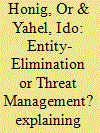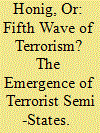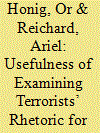| Srl | Item |
| 1 |
ID:
175704


|
|
|
|
|
| Summary/Abstract |
Israel’s policy towards both terrorist semi-states (TSS)—Fatahland and Hamas-controlled Gaza—shows a puzzling variation over time between threat-management (i.e., deterrence and/or brute force capacity-reduction) and entity-elimination. We hold that a military-based cost-benefit analysis cannot fully account for this variation. This explanation predicts that Israel would avoid the costly and risky TSS-elimination as long as Israel can effectively manage the military danger through the much cheaper deterrence/periodical capacity reduction or when there is a high risk of not getting a much better option partly due to the danger of creating a power-vacuum into which other terrorists may reenter. Yet, some Israeli Prime Ministers pursued TSS-elimination notwithstanding the vacuum consideration and deterrence working. By adding a non-military variable—the extent to which Israel’s policy-makers believe that the TSS harms their ideologically-preferred foreign policy goals—we can better reconstruct changes in threat perception and hence better explain policy variation. The TSSs became an intolerable danger only when non-military threats were involved. Israel was willing to tolerate TSSs when the Prime Minister believed they did not pose a political/ideological threat but sought to eliminate them when he thought they did, if there seemed to be a feasible alternative.
|
|
|
|
|
|
|
|
|
|
|
|
|
|
|
|
| 2 |
ID:
160128


|
|
|
|
|
| Summary/Abstract |
As part of their common efforts to undermine public support for their militarily-stronger adversaries' war efforts, insurgents and other militarily weak actors often accuse governments of fighting in a brutal manner and of committing brutal acts such as deliberately targeting innocent civilians. While sometimes there is sufficient evidence to support this claim of the government's deliberate brutality, other times militarily-weak actors will lack sufficient evidence to support this allegation. In such situation of lack of evidence, instead of making only those minimal allegations which can still be support by existing available facts, some weak actors decide nevertheless to make unsubstantiated claims and resort to fabricating the necessary evidence. This behavior presents a challenge not only for many counterinsurgent governments but also for the larger international community (most notably by diverting attention away from real atrocities). We identify some of the most common evidence-forging techniques recently employed by weak actors designed to create the factual basis to support of their chosen (often false) narratives of government brutality. The study also discusses some implications for international actors to prevent rewarding faking of atrocities.
|
|
|
|
|
|
|
|
|
|
|
|
|
|
|
|
| 3 |
ID:
076952


|
|
|
|
|
| Publication |
2007.
|
| Summary/Abstract |
This study explains Israel's insufficiently discriminate use of strategic assassinations during the last two decades. It shows that the tool's misuse considerably diminished its overall contribution to Israel's national security. It identifies five dimensions of systematic misuse: timing, political views of the targets, organizational affiliation, domestic political consequences for the adversary, and the visibility of Israel's responsibility. It finds three clusters of causes for these patterns of misuse: a flawed decision-making culture, the prevalence of false causal stories, and the pernicious effect of norms. This study could not find evidence for a direct link between domestic political pressures to any systematic pattern of misuse
|
|
|
|
|
|
|
|
|
|
|
|
|
|
|
|
| 4 |
ID:
169929


|
|
|
|
|
| Summary/Abstract |
Drawing on Rapoport’s four waves thesis, this study asks whether the emergence of terrorist semi-states (TSS) in the 21st-century MENA region and Pakistan mean that we are seeing the beginning of a new (fifth) wave. We define a TSS as a rebel group that a) has control over portions of a weak state’s territory, maintaining governance there; b) but still launches terrorist attacks against third-party states. To be considered a fifth wave, the new terrorism phenomenon at hand must both fit Rapoport’s criteria of a wave (be global, have the same driving force) and also be significantly different from the prior wave. Clearly, the TSSs are different from the religious terror groups of the fourth wave in key respects: they prioritize territorial control, they engage in a much wider array of governance activities (not just social services), most of their victims have been members of the same religion—namely, Muslims (which suggests that they are driven more by the pursuit of power than by Jihad); and finally, their behavior (though not their statements) shows they have a local rather than a universal agenda. The main counter-argument is that TSSs are all Islamic and have so far not been exported globally.
|
|
|
|
|
|
|
|
|
|
|
|
|
|
|
|
| 5 |
ID:
081249


|
|
|
|
|
| Publication |
2008.
|
| Summary/Abstract |
This study seeks to adjudicate between the two schools of intelligence: the "Orthodox School" which argues that the inherent pathologies and obstacles in the intelligence work make a significant degree of successful surprise inevitable in almost all attempts and the "Revisionist School" which asserts that the roots of surprise attacks lie in avoidable mistakes of certain intelligence officials. By examining the classic case of the Yom Kippur surprise attack, the paper finds the middle ground between the two schools. It distinguishes between the real limits facing analysts and surmountable obstacles. Based on this distinction it determines which problems can be corrected or mitigated and which cannot. It also provides criteria to determine the varying levels of difficulty for predicting attacks. Finally, it finds that intelligence inevitably involves making subjective judgments and utilizing experience correctly, and therefore successful prediction depends on the quality of the analysts
|
|
|
|
|
|
|
|
|
|
|
|
|
|
|
|
| 6 |
ID:
169910


|
|
|
|
|
| Summary/Abstract |
This study advances a distinction between two generic types of terrorists’ rhetoric: (1) ideological rhetoric candidly reflecting the terrorists’ genuine beliefs and values regarding their military targeting policy (who is a legitimate target), even when adopting such rhetoric involves high image/diplomatic costs; and (2) a PR-oriented rhetoric which consciously misrepresents the terrorists’ intentions and behavior in an attempt to project a more benign and humane image, thus maintaining sympathy and rebuffing criticism. We contend that such a distinction can provide a highly useful metric for assessing terrorists groups’ rationality and pragmatism: the most pragmatic groups will shift between these two types of rhetoric depending on changing strategic needs. To show the practical usefulness of this distinction we provide criteria for categorizing terrorists’ rhetorical responses to (mostly liberal-minded) criticism that they have killed innocent civilians in their enemy’s camp. We apply our criteria by examining terrorists’ (sincere and insincere) apologies.
|
|
|
|
|
|
|
|
|
|
|
|
|
|
|
|
| 7 |
ID:
113864


|
|
|
|
|
| Publication |
2012.
|
| Summary/Abstract |
Following costly military defeats political elites usually attempt to persuade their publics that the battlefield outcome was not a shameful defeat but a 'moral victory'. Yet, only sometimes their public accepts these claims. The paper tries to explain this variation in the domestic publics' perceptions in the cases of non-democratic entities. It is argued that the key variable that determines actors' success in claiming a moral victory is the existence of certain battlefield elements, or at least symbolic military acts/achievements of the defeated actor which can persuade his public that these battlefield elements existed. Propaganda efforts to misrepresent the battlefield facts can play only a secondary role and only under certain conditions.
|
|
|
|
|
|
|
|
|
|
|
|
|
|
|
|